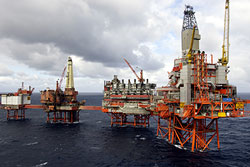- Chemical Corrosion
- Chemical Corrosion from acids, salts, sea water, photo compounds, fuels, and other oxidizing agents destroys literally billions of dollars of metal equipment each year. Pump impellers, process rolls, pillow blocks, brackets, and thousands of other parts are oxidized to failure by corrosives. Sometimes failure is as simple as a pit on the surface of a hydraulic piston that cuts a gland seal; in other cases, failure is total structural collapse.
|
Xylar® 2 and 2/101 are the building blocks to corrosion protection. Xylar® 2 is a porous ceramic coating that is extremely hard and, with respect to structural metals, is chemically sacrificial. Applied to ferrous, aluminum, or other metals, it is "sacri- ficed" to a corrosive medium before the substrate is attacked. Xylar® 101 is a sealer/topcoat that closes any surface pores of Xylar® 2. The 1 to 1.5 mil (0.0254 to 0.0381 mm) combination provides an incredible 4,000+ hours of protection in ASTM B117 salt fog tests. |
Xylar® 2 gives 300 to 400 hours of salt fog protection, or about 6,000 hours of protection when topcoated with Xylar® 101. Recommended applications include pump impellers, turbine blades compressor housings, valve bodies, agitators, petrochemical reactor parts, paper machine components, exhaust stacks, marine hardware, equipment used in photo processing, or other parts that need thin film protection - at temperatures all the way up to 1,200°F/650°C.
|
- Galvanic corrosion
- Galvanic corrosion occurs when dissimilar metals are joined so that there is an electrically conductive path between them. Usually, failure occurs around points of contact such as fasteners and can lead to total loss of load-carrying capability. The classic example is the union between auto- motive bodies and aluminum kick guards that are mounted on the door sills; metal-to-metal contact between the body (steel) and the kick panels promotes corrosion of both.
|
Xylar® 2 cermet coating breaks the electrical path between dissimilar metal parts. It is hard (8H), simple to apply, and because it is so thin (1 to 1.5 mils) it does not interfere with most component tolerances. The high temperature stability of
Xylar® 2 (1,200°F/650°C) makes it ideal for engine applications where the electrical couple between dissimilar metals could result in corrosion.
|
Xylar® 2 and 2/101 are used to separate dissim- ilar metals in engine/generator applications, sus- pension mounts, air cylinders, electrical controls, industrial brakes and clutches, air pumps, reels, materials-handling equipment, industrial ovens, tubing systems, gear reducers, ball screws, governor systems, motor housing, and literally hundreds of other applications - at ambient or extreme temperatures. |
- Abrasion and Erosion
- Abrasion and Erosion are the gradual loss of a sub- strate due to wear from a mating surface, harsh particles, or cavitation. On rotating parts, this results in imbalance and unexpected stresses on shafts and bearings. On static parts, it results in loss of strength and eventual failure.
|
Xylar® 2 cermet coatings provide an extraordinari- ly hard barrier shield against abrasive wear. By itself, Xylar® 2 protects against coarse slurries, cavitation, stone pecking, or erosion from fly ash. Where release of abrasives is required, Xylar® 2 can be topcoated with Xylar® 201 to form a hard matrix film with unsurpassed release. |
Xylar® 2 is used in abrasive applications such as furnace chutes, air ducts, grain-handling equip- ment, and numerous vehicle-underbody compo- nents where abrasive wear or stone pecking is common. The combination of Xylar® 2/201 is pre- ferred for applications where parts wear against each other, or where parts are dragged over abrasive media. |
- Friction
- Friction is produced when two mating parts slide over each other. Even under light loads, momen- tary contact between the two surfaces causes minute asperities (surface projections) to weld together, then shear away. Also, rubbing contact generates heat - so much so that properties of both the metal parts and fluid lubricants can be damaged.
|
Xylar® 2/201 is an extremely hard dry-film lubricant with a friction coefficient of 0.06. No other sprayable coating system can match its wear characteristics or its temperature stability (600°F/315°C). Also, because this combination of coatings is thin - as thin as 1 mil - it can be used on precisely fitted parts without interfering with their tolerances. |
Xylar® 2/201 performs better than any existing dry-film lubricating coating in bearing and wear applications such as power screws, gears, com- pressor rotors, clutch actuators, slides, and valves. It is also an excellent coating to use in lightly loaded conditions where "stick-slip" is a problem. Examples include handbrake compo- nents where aluminum slides against aluminum or stainless slides against stainless. |
